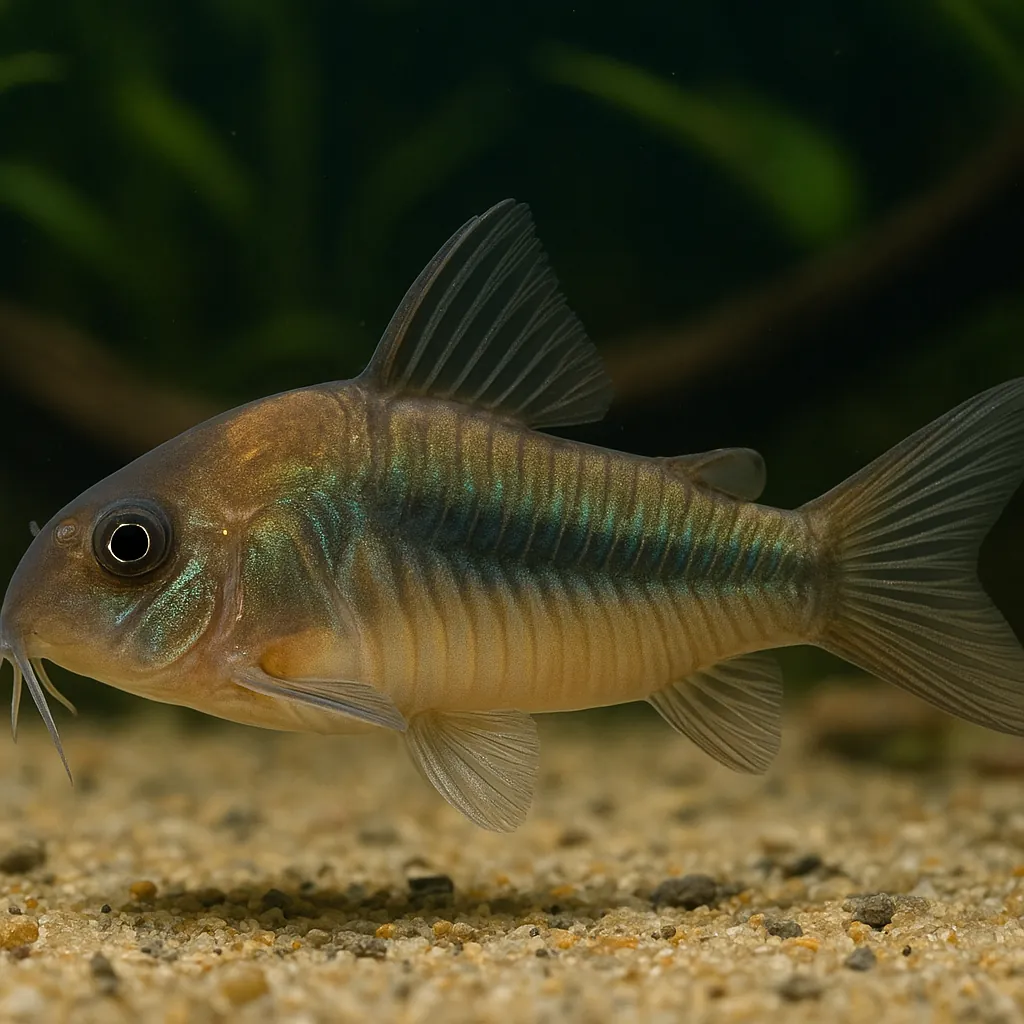
Bronze cory
Introduction
The Bronze corydoras (Corydoras aeneus), also known as the Bronze catfish, is a popular choice among freshwater aquarium enthusiasts. Renowned for their peaceful nature and hardiness, these bottom-dwelling fish are ideal for community tanks. Their unique appearance and engaging behaviors make them a delightful addition to any aquarium.
What makes the Bronze corydoras a favorite among aquarists?
Bronze corydoras are favored for their peaceful temperament, ease of care, and their role as efficient scavengers, helping to keep the tank clean by consuming leftover food.
Are Bronze corydoras suitable for beginners?
Yes, their hardy nature and straightforward care requirements make them an excellent choice for novice fishkeepers.
Care and Environment
Proper care of Bronze corydoras involves attention to tank size, water parameters, substrate, feeding, and tank decor.
What is the minimum tank size for Bronze corydoras?
A minimum tank size of 20 gallons (approximately 75 liters) is recommended to accommodate a small group, as they are social fish that thrive in groups of at least six.
What are the ideal water parameters for Bronze corydoras?
They prefer water temperatures between 22°C and 26°C, a pH range of 6.0 to 8.0, and water hardness between 5° to 20° dH.
What type of substrate is best for Bronze corydoras?
A soft sand or smooth gravel substrate is ideal to prevent damage to their sensitive barbels, which they use to forage for food.
How should the tank be decorated for Bronze corydoras?
Incorporate plenty of hiding spots using driftwood, rocks, and live plants like Java Fern and Anubias to provide shelter and reduce stress.
What is the recommended diet for Bronze corydoras?
They are omnivores and should be fed a balanced diet of high-quality sinking pellets, supplemented with live or frozen foods such as bloodworms and brine shrimp.
How often should water changes be performed?
Regular water changes of 20-30% weekly are recommended to maintain water quality and prevent the buildup of harmful substances.
Origin and Habitat
Bronze corydoras are native to South America, inhabiting countries such as Argentina, Colombia, and Venezuela. They are typically found in quiet, shallow waters with soft bottoms, including slow-moving rivers, streams, and floodplains. These environments often have soft, sandy substrates and are rich in vegetation, providing ample hiding spots and foraging opportunities.
What type of water bodies do Bronze corydoras inhabit?
They inhabit slow-moving rivers, streams, and floodplains with soft, sandy bottoms and abundant vegetation.
Do Bronze corydoras prefer specific water conditions in the wild?
Yes, they thrive in waters with temperatures ranging from 25°C to 28°C, a pH of 6.0 to 8.0, and hardness between 5 to 19 dGH.
Temperament and Compatibility
Bronze corydoras are peaceful, social fish that thrive in groups and are well-suited for community tanks.
Are Bronze corydoras shoaling fish?
Yes, they are shoaling fish and should be kept in groups of at least six to promote natural behaviors and reduce stress.
What tank mates are suitable for Bronze corydoras?
They are compatible with other peaceful species such as tetras, swordtails, and other corydoras species.
Which tank mates should be avoided?
Avoid housing them with larger, aggressive species like Oscars, Texas cichlids, and Jack Dempseys, as these can harm or prey on Bronze corydoras.
Interesting Facts
Bronze corydoras possess several unique traits that make them fascinating additions to aquariums.
Do Bronze corydoras have any special breathing abilities?
Yes, they can breathe atmospheric air by rapidly surfacing to gulp air, which is then absorbed through their intestines—a trait that allows them to survive in low-oxygen environments.
Are there different color variations of Bronze corydoras?
Yes, there are color variations such as the albino form, which has a pale pink or orange body with red eyes.
How do Bronze corydoras reproduce?
They spawn with the onset of the rainy season, with females laying eggs on various surfaces, which are then fertilized by males.
Sources
All information in this article has been gathered from the following reputable sources:
Overview
Recommended Tank Size 19.8 Gallons (for groups of 6 or more) |
Minimum Group Size 6 |
Minimum Tank Volume 19.8 Gallons |
Maximum Adult Length 3 inches |
Average Adult Length 2.6 inches |
Shoaling (6+ required) Yes |
Preferred Water Type Freshwater, soft to slightly hard, acidic to neutral |
Temperature Range (°C) 22–26 |
pH Range 6.0–8.0 |
Water Hardness (dGH) 5–20 |
Typical Lifespan (years) 3 years |